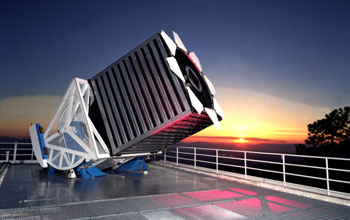Multimedia Gallery
Sloan Digital Sky Survey's
The 2.5-meter Sloan Digital Sky Survey (SDSS) telescope, located at Apache Point Observatory in New Mexico. The telescope is unusual because it has a remarkably wide-angle view, and because it was made specifically to create a map of the sky. The telescope's camera uses electronic sensors that turn light into a stream of digitized data. The telescope also uses two spectrographs--instruments that probe the composition and distance of celestial objects. Here you can see the fully assembled telescope. The boxy metal structure is the outer wind baffle, mounted separately from the rest of the telescope. It helps prevent the wind from shaking the telescope.
In March 2004, the SDSS released one of the largest astronomy catalogs ever compiled. The data, which included photometric and spectroscopic observations of the sky gathered over a two year period, was released as images and catalogs and included two terabytes in an easy to use searchable database. Digital images and measured properties of more than 88 million celestial objects are also included. SDSS is the largest undertaking ever attempted, and includes a consortium of more than 200 astronomers at 13 institutions worldwide.
Funding for the SDSS and SDSS-II was provided by the National Science Foundation, the Alfred P. Sloan Foundation, participating institutions, the U.S. Department of Energy, NASA, the Japanese Monbukagakusho, the Max Planck Society, and the Higher Education Funding Council for England. (Year of Image: 2000)
Credit: Fermilab Photo
See other images like this on your iPhone or iPad download NSF Science Zone on the Apple App Store.
Images and other media in the National Science Foundation Multimedia Gallery are available for use in print and electronic material by NSF employees, members of the media, university staff, teachers and the general public. All media in the gallery are intended for personal, educational and nonprofit/non-commercial use only.
Images credited to the National Science Foundation, a federal agency, are in the public domain. The images were created by employees of the United States Government as part of their official duties or prepared by contractors as "works for hire" for NSF. You may freely use NSF-credited images and, at your discretion, credit NSF with a "Courtesy: National Science Foundation" notation.
Additional information about general usage can be found in Conditions.
Also Available:
Download the high-resolution TIF version of the image. (49 MB)
Use your mouse to right-click (Mac users may need to Ctrl-click) the link above and choose the option that will save the file or target to your computer.

